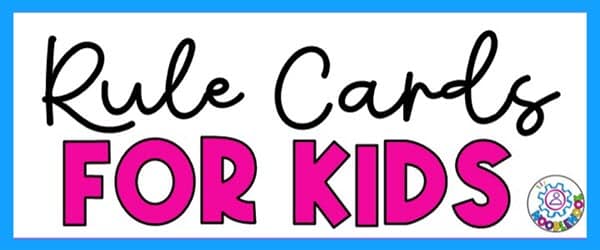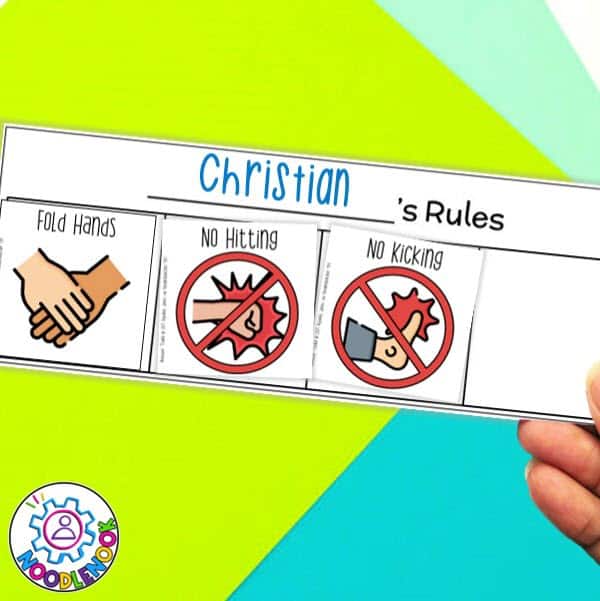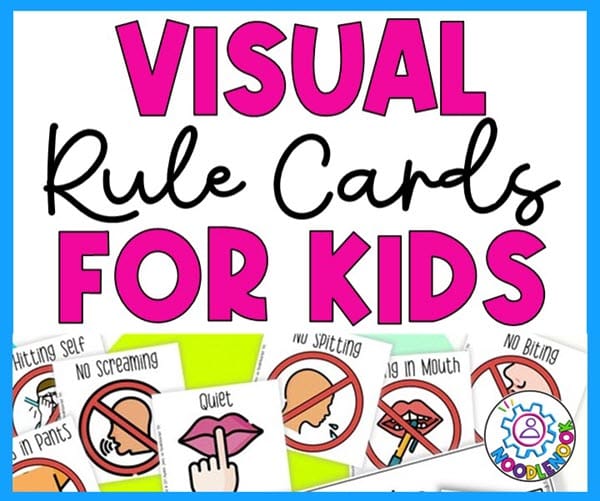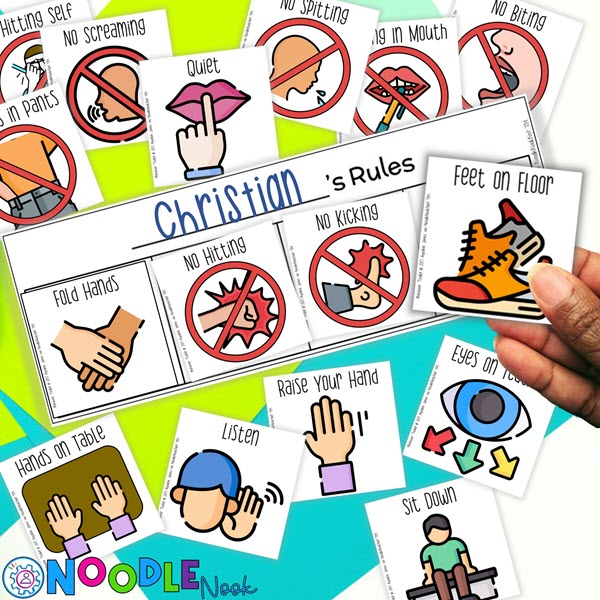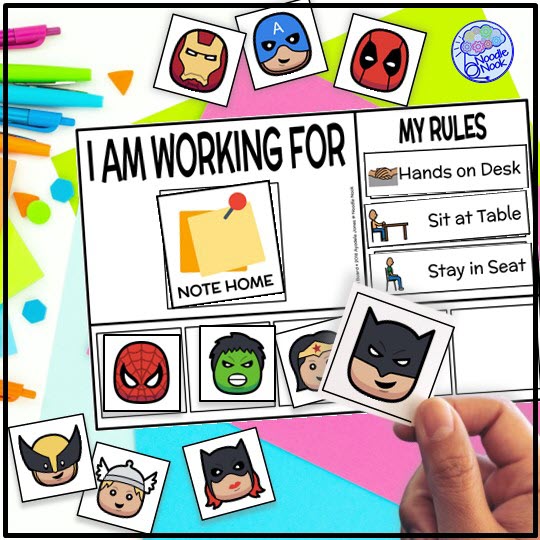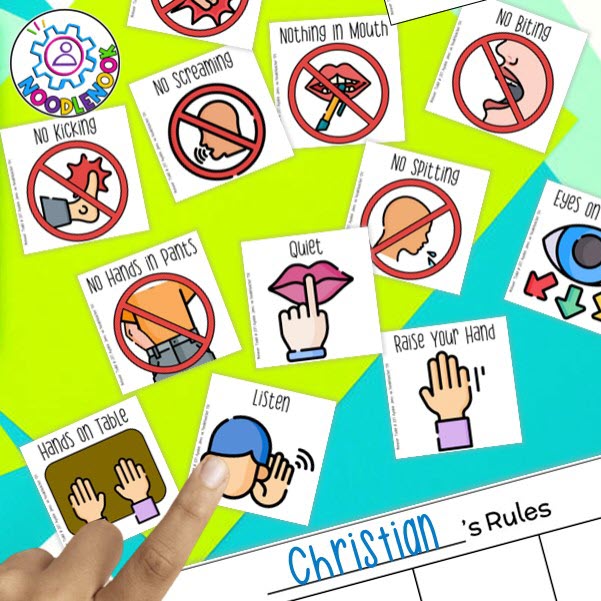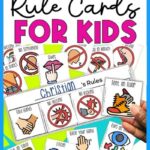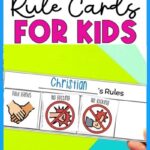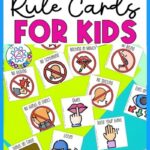In the world of education, teachers often find themselves in situations that are, well, less than magical. We might not wield wands or wear capes, but with the right visual supports and strategies, we really can make magic happen in the classroom. If you’ve ever taken a step back in your class and witnessed chaos reigning supreme, with students whirling around like mini-tornadoes, then you know that sometimes our classroom resembles a battleground. This is exactly why I love visual rule cards for kids with special needs, and honestly, they work wonders with every kid. I know what you’re thinking: “Why do I need cards to explain the rules? My kids know what I expect of them.” But do they really? In this post, we’re going to talk about visual rule cards for kids with special needs and exactly how they can be a game-changer for behaviors and your instructional approach.
What Are Visual Rule Cards?
Visual rule cards are simple tools used in a special education classroom to illustrate and reinforce specific rules and expectations. These cards typically feature a short, straightforward description of a rule in simple words. Those are usually accompanied by a visual representation, such as an icon or image.
The primary purpose of these cards is to provide a clear and tangible reference for students. This makes it easier for them to understand, remember, and follow the rules. They serve as visual cue cards that help students understand classroom expectations in different ways. The use of visual supports with special needs students promotes consistency, reduces misunderstandings, and supports positive behavior. On top of that, it helps to make sure everyone in class is on the same page regarding the rules.
Why Use Visual Rule Cards
Now that we have a clear understanding of what visual rule cards are, let’s get into why they are a valuable addition to your teaching toolkit. While it might seem straightforward to communicate and enforce rules verbally, visual rule cards offer several distinct advantages:
- Clarity: Visual rule cards make rules explicit and easy to comprehend. Students and teachers can refer to the cards whenever they need a reminder, leaving no room for ambiguity.
- Consistency: These cards ensure that rules are consistently reinforced. Regardless of who the teacher is or where the student is in the classroom, the same rules apply.
- Independence: Visual rule cards help students to take responsibility for their behavior. They can self-monitor and self-regulate, making it easier for them to follow the rules.
- Accessibility: Visual rule cards are accessible to all students, including those who may have difficulties with language or verbal communication. That makes them inclusive for students with special needs.
- Reduction of Anxiety: For students with special needs or anxiety, knowing what is expected can reduce stress and create a more comfortable learning environment.
Clearly, there are a lot of benefits to having visual rule cards for students with special needs. They aren’t just a convenience but a game-changer. They provide extra support for behavior management and effective instruction.
Who Benefits from Using Visual Rule Cards?
Although this post is about how rule cards benefit students with special needs, like autism spectrum disorders, that is not the whole truth. Visual rule cards can have a positive outcome for a variety of students. They are truly versatile in the school setting as an inclusive tool, making them beneficial for a broad range of students. Here’s who stands to gain the most:
- Students with Special Needs: Visual rule cards are particularly helpful for students with disabilities or special needs. They provide a clear and accessible way to understand and follow rules.
- Early Elementary Students: Young children who are in the early stages of their education often benefit from visual cues. Visuals help as they are still developing their reading and comprehension skills.
- English Language Learners: Visual rule cards transcend language barriers, making them useful for students who are learning English.
- Students with Behavioral Challenges: Visual rule cards can assist students who struggle with behavior management by offering clear guidelines and expectations.
- Autistic Students: Visual supports, including rule cards, are often an integral part of working with students on the autism spectrum. They can help reduce anxiety and promote positive behavior.
- Any Student in Your Classroom: Visual rule cards create an inclusive classroom environment. They ensure that all students, regardless of their learning style or abilities, have a consistent and clear understanding of the rules.
What I love most about these visual aids is that they support students of all levels in their daily routine. You can use them with high school. middle school, and elementary-aged students. These visual reminders are easy access for visual learners who may have difficulty understanding verbal directions or struggle with social skills and communication skills. And, when students have a variety of ways to access the rules and expectations, they are more likely to find success during the school day.
How to Implement Visual Rule Cards
Chances are, you already have a set of rules posted in your classroom for all students to see and for you to reference. When it comes to implementing visual rule cards for special needs students, the key is to make them specific to a task or a particular area, such as a learning center.
I prefer to have rule cards taped to the desks in my independent work stations, each tailored to the needs of specific students. Additionally, I place rule cards at each individual seat in my small group instruction station. To make them easily adjustable, I attach the rules with Velcro. This flexibility allows me to adapt the rules based on the activity we’re doing and the students who are in my group.
As I move the cards around, I take the time to review them with the students, to make sure they are well aware of the expectations as we begin each activity. Then, as we are working, I may reference the rule again as needed. Of course, as much as possible, I point out when a student is following specific rules. Let’s face it, positive praise is the secret sauce here.
Steps to Implementing Visual Rule Cards
To recap, here are the specific steps to implementing visual rules in your classroom:
- Print the Cards: Print your visual rule cards. Try to keep the number of rules between 2-5, with five being the most you should have.
- Choose the Rules: Reflect on your students and pick the rules or expectations that you want to reinforce. Consider the unique needs of your students and the specific areas or tasks where these rules will apply. Remember, the rules in the bathroom may not be the rules in social situations and those may not be the rules in physical education. Tailor your rules for different settings to best support students.
- Introduce Them to Students: Introduce the visual rule cards to your students. Explain the purpose of the cards and how they represent the rules and expectations in the classroom.
- Review with Students: Take the time to review the visual rule cards with your students before you start tasks throughout the day. Check that they understand the meaning and significance of each rule. This step is crucial for making the cards effective.
- Reference Frequently: During instruction, reference the visual rule cards frequently. Use them as a visual reminder of the rules, especially when transitioning between activities or tasks.
- Use Positive Praise: When a student follows a rule depicted on a visual card, provide positive praise that is specific to the rule they’ve followed. For example, “Great job keeping your hands to yourself, Dejah!” or “Wow Brayden! You followed the ‘Raise Your Hand’ rule perfectly!”
For even more effective behavior management, consider pairing visual rule cards with token boards. Token boards provide a tangible way to track and reward positive behavior, reinforcing the use of the rule cards. I love a token board that embeds the rules for students who need a constant reminder. You may also want to have access to a break card as well. You can read more about those here. When you stack visual behavior supports, you capitalize on evidence-based practices that actually support student success and classroom management.
What To Do When Things Go Wrong
While visual rule cards are a powerful tool for behavior management, there may still be times when things don’t go as smoothly as expected. We’re teachers! Nothing is perfect the very first time we try it. That means it’s essential to have a plan in place for when things don’t go as planned:
- Stay Calm: If a student has difficulties following the rules or using the visual cards, it’s important to remain calm and composed. Your patience and demeanor can make a huge difference.
- Have a Conversation: Take a moment to have a private conversation with the student as soon as possible. Move away from the other students and use a quiet voice. Use active listening to understand their feelings and needs.
- Reteach and Review: Once you’ve identified the challenges, it’s time to reteach and review the rules and the purpose of the visual cards. Revisit the specific rule the student struggled with and ensure they understand its importance.
- Adapt and Modify: Recognize that not all students are the same. Be flexible in adapting your approach and how the student uses their visual rule cards. What works for one student may not work for another, so consider adjustments.
- Reinforce with Positivity: Although you may be addressing challenging behaviors, it’s important to maintain a positive and supportive classroom environment. Use positive praise as much as possible as a reinforcer and motivator for students.
By following these steps when things don’t go as planned, you can effectively address challenges and continue to use visual rule cards as a valuable behavior management tool.
Sample Scenarios for Visual Rule Cards
It is super helpful to see specific situations when you’d use visual rule cards for kids with special needs. Visual rule cards can be tailored to specific scenarios to address a wide range of challenges, like these:
- Disruptive Student: For a student who tends to be disruptive in class, a visual rule card can outline specific classroom behaviors expected during instructional time. It can include reminders to raise their hand to speak, listen actively to the teacher, and maintain a quiet and focused work environment. Positive praise can be used when the student follows these rules.
- Self-Stimulation or Self-Injury: In the case of a student who engages in self-stimulation or self-injury, a visual rule card can offer alternative strategies for self-regulation. It can depict actions like taking deep breaths or using a fidget tool. This card can remind the student to use these strategies when needed and reduce self-stimulatory or self-injurious behaviors.
- Off-Task Student: A student who frequently gets off-task can benefit from a visual rule card that outlines specific steps for staying on track. It can include instructions to stay seated, focus on the task, and seek teacher assistance when needed. Using a token board in combination with the rule card can help track and reward on-task behavior. Read more about token boards here.
- OCD or Repetitive Behaviors: For students with OCD or repetitive behaviors, a visual rule card can provide guidance on how to manage these behaviors proactively. It can include reminders to engage in a specified calming activity. Likewise, it could support students to follow a step-by-step routine when the urge for repetitive behavior arises. This card aims to help the student reduce obsessive or repetitive actions.
- Early Elementary Student Learning Etiquette: Visual rule cards can be invaluable for early elementary students who are just learning classroom etiquette. These cards can cover fundamental rules. These include things like raising hands to speak, using indoor voices, staying in assigned seats, and following the teacher’s instructions. Using visual cues can make it easier for young learners to understand and follow these rules.
In each scenario, the key is to create visual rule cards that are tailored to the specific needs of the student and the behavior or challenge you are addressing. These cards serve as a visual reference and reminder of the expected behavior, making it more accessible and achievable for the student.
RECAP: Visual Rule Cards for Kids with Special Needs
Visual rule cards are a powerful and adaptable tool for teachers working with students who have special needs. Used as an early intervention, they can be a game changer for classroom management. They provide a clear and structured way to convey classroom rules and expectations, which makes them perfect for autism classrooms, life skills, or when working with students who have developmental disabilities. These cards are not just for students with special needs; they can work wonders for all students.
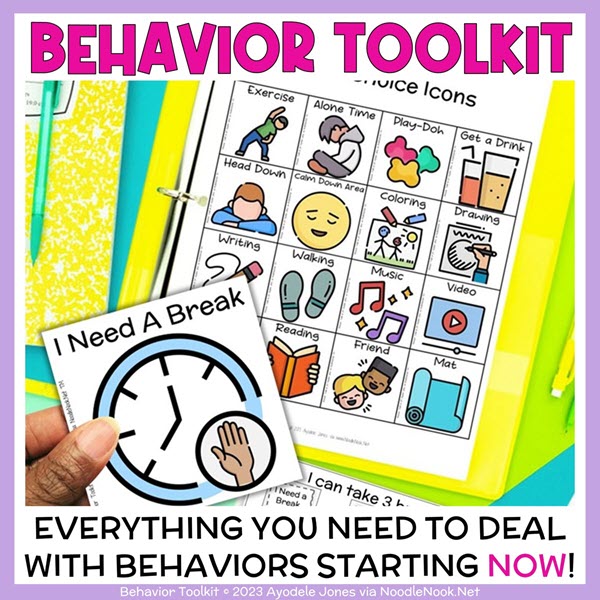
Are you a believer? Can you see the magic of visual rule cards for kids with special needs in your classroom? Get started today with this amazing tool and start addressing specific behaviors or challenges with your students. To get started fast, get The Behavior Toolkit from NoodleNook. It comes with a variety of behavior tools, including Visual Rule Cards!
🔗 And if you know you want to pair visual rule cards with token boards, then you need the Token Board Printable Pack. It comes with premade rules and a variety of engaging tokens that students love.
By using these tools, you can create an inclusive and supportive learning environment that helps students understand and follow the rules effectively. And that helps you manage behaviors and teach better. So what are you waiting for?

